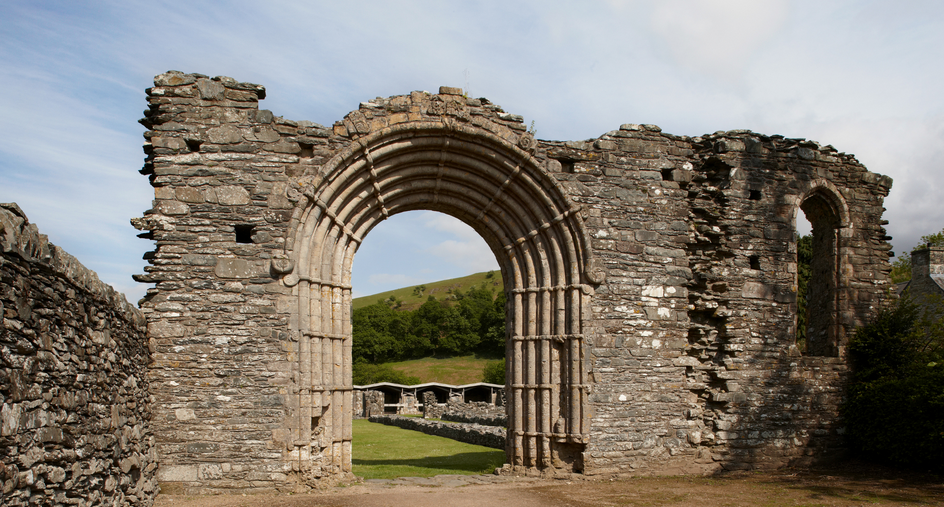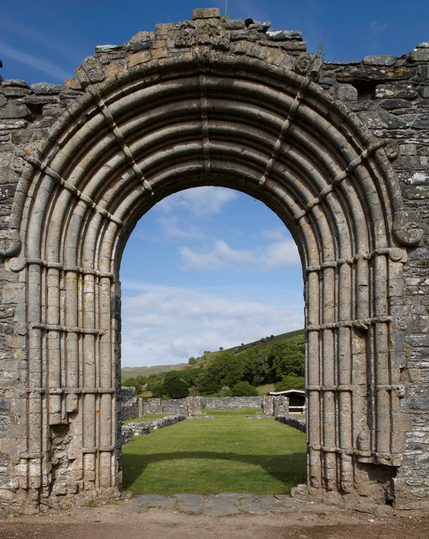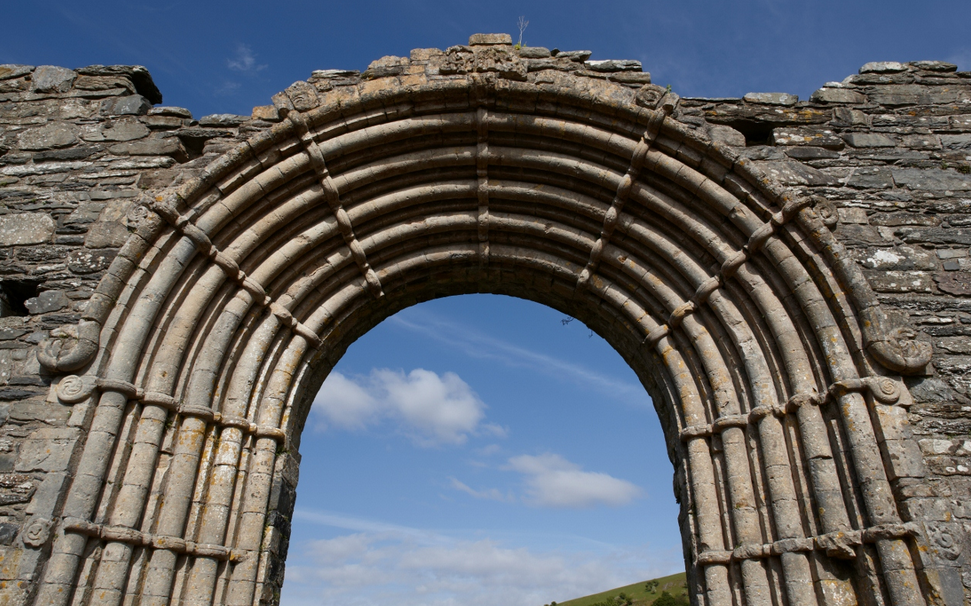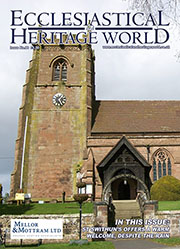Strata Florida Abbey – 850 years of inspiration
 This year marks the 850th anniversary of Strata Florida abbey – a monument that’s both admired for its captivating beauty and famed for its historical importance.
This year marks the 850th anniversary of Strata Florida abbey – a monument that’s both admired for its captivating beauty and famed for its historical importance.
Believed to be the resting place of Dafydd ap Gwilym, one of Wales’s best known medieval poets, the site still attracts literature lovers through its majestic carved doorway today. The Ceredigion wonder was once home to Cistercian monks of the Middle Ages.
Built by medieval monks
850 years ago making a 50 mile journey through medieval Wales would have been a daunting task for the small group of monks responsible for founding Strata Florida Abbey.
In 1164, the Cistercian monks set out from the security of their mother abbey at Whitland in Carmarthenshire and travelled north. It was a turbulent time in Wales as the native Welsh princes struggled to regain control over their land from invading Norman forces. However, in West Wales the balance of power had started to swing back to the Welsh with the rise of the kingdom of Deheubarth under the powerful lordship of Prince Rhys ap Gruffudd, also known as The Lord Rhys. Fortunately for the monks at the newly established Abbey he proved to be a strong and generous patron.
In a charter of 1184, the Lord Rhys granted the Abbey extensive lands that guaranteed an income sufficient to support the construction of a glorious new Abbey church on the banks of Ystrad Fflur, where the surviving ruins can still be seen to this day.
Recent discoveries
The ruins, now in the care of Cadw, have seen something of a reawakening in recent years.
Investigations carried out by staff and students from the Trinity St Davids Lampeter Campus have uncovered evidence for long lost buildings in the abbey precinct including the outer gatehouse and Abbey mill while aerial photography is revealing the full extent of the Abbey estate and grange farms, which extended far up into the surrounding hills.
The many facets of life in Strata Florida and the people who lived, worked and visited there are now presented at the Cadw visitor centre. Artefacts recovered from excavations are on display, such as tools, coins and personal objects used by the monks and craftsmen. Amongst the most intriguing are two broken slate tiles inscribed with lines of poetry written in medieval Welsh and sketches of foliage – perhaps the practice pieces of a novice poet? But not all the artistic work of the Abbey was always entirely above board – also on display are fake coins that a monk was caught red-handed attempting to forge!
Installation of the exhibition provided several challenges, including the need to temporarily remove and re-install a giant grave-slab weighing over half a ton. When the slab was originally discovered in the Abbey Chapter House, it was found to cover a group of disarticulated bones from at least twelve individuals. We don’t know who these people were, but burial within the Chapter House was an honour usually reserved for Abbots and most respected patrons. This broken gravestone has been painstakingly pieced back together and is now safely displayed within the visitor centre.
Royal resting place
Throughout history, the Abbey appears to have been held in special regard by the royal Princes of Deheubarth. Nine of their family are known to have been buried here including Cadell, Rhys’s own brother.
The monks of Strata Florida remained fiercely loyal to the Welsh cause, and became significant custodians of its native cultural traditions. It was at the Abbey that the choir monks kept and translated the Chronicle of the Princes, or Brut y Tywysogion, from Latin into Welsh. This manuscript is still one of the most important historical records of medieval Wales and is preserved today in the National Library of Wales.
While the choir monks transcribed books, the lay brothers worked the lands, transforming the valley bottom from wilderness to fertile fields. During the 13th century the Abbey grew and masons and carpenters built the monumental edifice of the church, embellishing it with fine carved stone, an intricate timber roof and decorative tiled floors.
Inspirational
At its height Strata Florida was a popular stopping-off place for poets who travelled the land seeking room and board in return for providing poetry and entertainment.
Most famous of these was Dafydd ap Gwilym, who lived during the 14th century. What the monks made of his poetry can only be imagined since it was earthy and rich and filled with references to his love of women. According to tradition he was buried at Strata Florida beneath the yew tree which stands in the churchyard, and to this day the site remains a place of pilgrimage for all lovers of Welsh poetry.
 A sad end
A sad end
The end of the Abbey came in the 16th century when Henry VIII ordered the monasteries to be closed down and their lands sold. The abbey was abandoned and over the following centuries fell into ruin, its buildings robbed for stone. Yet miraculously the beautiful and unique west doorway survived and remains to this day as a welcoming sight for visitors to this remarkable and tranquil cultural site.
Open 10am-5pm daily
A modern day pilgrimage
How much do you know about Wales’s religious history? Here we take a look at some of the country’s most significant religious, historic buildings.
Lamphey Bishop’s Palace
Standing just two miles from the town of Pembroke in West Wales, this once lustrous site served as a country retreat for bishops from St Davids.
What can be seen at the Palace today is mainly the work of the dynamic Henry de Gower, the bishop of St Davids from 1328 to 1347. Thanks to his vision, elegant Lamphey became the place to be for high-ranking members of the clergy keen to play at being country gentlemen. With buildings dating from the 13th-16th century, Lamphey Bishop’s Palace consists of numerous halls and chapels.
Bishop Gower’s great hall, 82 feet (25m) long, is a particularly fine architectural achievement and its sheer grandeur would have impressed even the most privileged of bishops.
Open 10-5pm daily
Rug Chapel
This 17th century chapel stands on the banks of the River Dee in Denbighshire. A beautiful and peaceful site, it was founded as a private chapel by Arch Royalist Colonel William Salesbury. Contrary to its modest exterior, the interior of the chapel is decorated decadently with fine wood carvings and rose motifs. As a leading Welsh scholar and principle translator of the 1567 Welsh New Testament, the chapel would have been a base for Colonel Salesbury’s advocacy of the Welsh language.
Open 10am-5pm Wednesday to Sunday
St David’s Bishop’s Palace
Situated within the heart of St Davids, this lavishly decorated palace which was once adorned with corbels carved as human heads and striking chequerboard stonework is a testament to the wealth and status of medieval men of religion.
Bishop Henry de Gower was responsible for virtually the entire palace we see today and his legacy can be seen within the fantastic wheel window in the east gable, the majestic porch and the great hall.
Built for drama, this once abundant palace plays host to many open air theatrical performances. Today, visual and audio interpretation displays bring this fascinating religious site to life with sounds of a busy bishop’s palace including bells, singings and even galloping horses.
Open 9.30am-5pm daily
St Dogmael’s Abbey and Coach House
The site takes its name from St Dogmael, a 6th-century Christian saint, reputedly the cousin of St David, the patron saint of Wales.
Set on the banks of the River Teifi in Cardigan, this twelfth century abbey was converted into a private mansion after the dissolution of the monasteries under Henry VIII. Visitors today enjoy an audio tour of this sacred building followed by a visit to a museum housed within the abbey’s converted coach house. It displays examples of the early Christian stones and beautiful carved medieval stones that once adorned the abbey.
Open 10am-4pm daily
 Tintern Abbey
Tintern Abbey
The best preserved medieval abbey in Wales, majestic Tintern sits merely yards away from the banks of the River Wye on the English border. The present-day remains are a mixture of building works covering a 400-year period between 1131 and 1536.
Visitors can marvel at the vast windows and later decorative details displayed in the walls, doorways and soaring archways and picture Cistercian life within the walls of this beautiful place.
Open 9.30am-5pm daily
Valle Crucis Abbey
Set in the remote but magical location of Llantysilio in Llangollen, this site is home to awe-inspiring natural views. From its cloister to the chapter house, with striking rib-vaulted roof.
Built to house pious Cistercian monks in the thirteenth century, the abbey was once governed by orthodox austerity but was later ranked as the second richest monastery after Tintern.
Open 10am-5pm daily. Last admissions 30 minutes before closing.
For more information about Cadw sites, visit www.cadw.wales.gov.uk.
















